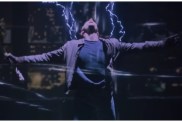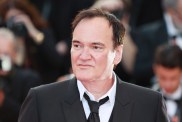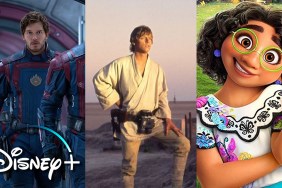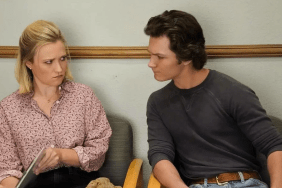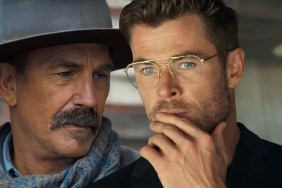Famous figures in sports are regular fodder for documentaries, but Formula 1 racing is a sport that’s somehow become forgotten in the United States while still being hugely popular the world over. Asif (The Warrior) Kapadia’s Senna takes a look at one of the luminaries in the sport, Brazil’s Ayrton Senna, who burst onto the scene in the early ’80s and fought his way to the first of three World Championships in 1988, building a rivalry against his teammate Alain Prost in the process.
What’s fascinating about the film is that unlike traditional docs, the story isn’t told in talking heads from those who were around the duo during these races, but instead showing actual footage from the races, as well as behind-the-scenes footage that has never been seen before. Kapadia and his team assembled this amazing footage into a fairly cohesive story showing what Senna went through to finally be recognized as one of the best Formula 1 racers of his time before his tragic death in 1994 due to a freak accident.
It may be somewhat surprising to learn that Kapadia wasn’t even a Formula 1 racing fan when he started making the movie, but from the excited way he talked to us about racing and Senna when ComingSoon.net sat down with him a few weeks back, you’d never know it.
ComingSoon.net: It’s an interesting movie for me because I’ve been around long enough that I would have known about Senna plus I have family in Brazil.
Asif Kapadia: Had you ever heard of him?
CS: No, I hadn’t. That’s also what was weird.
Kapadia: Isn’t that amazing? You have family in Brazil and you’d never heard of Senna?
CS: Well, I lived there when I was very young but I never followed racing, but as far as I could tell you hadn’t done any documentaries before this…
Kapadia: This is my first doc. I’m a drama guy.
CS: What spurred you to do your first doc then?
Kapadia: There’s many reasons for that. #1, the film I made previously to this I shot in the Arctic, I was shooting a film in the North Pole, and all my previous films, image is a big part of the film. I’m almost obsessed with how films look, so I was quite interested in doing a film where I had no control over that. I was almost testing myself by saying, “I don’t care what the footage looks like, I’m going to use it.” It’s just about story and character. There are other more personal things. I just had a kid so the idea was, “Well, I’d quite like to be in England and staying in one place,” because the films I’ve made before were all over the world. Weirdly enough, I’m a big sport fan, which was the bigger thing–I love sport, and I was into sport long before I was into any kind of cinema–so the idea of making a film about a real great sporting hero. I’ve tried to develop movies about sport and they don’t work. The thing about sport is that they need to be done for real…
CS: Sure, because most people will know the story and the outcome…
Kapadia: It just feels fake. When you try and take what actually happened and you put it into dramatic form and you condense it, you just don’t buy it. So Muhammad Ali, no matter how good the director or the actor, Muhammad Ali should play Muhammad Ali, and “Hoop Dreams” and documentaries like were quite an inspiration and “When We Were Kings.” The chance to test myself in a doc form about an amazing character that I know millions of people around the world know, but the biggest challenge for me was how do we make this film for people like yourself who never heard of the guy? For people who don’t like sport, who can’t stand the idea of motor racing? That was the challenge, and really, I didn’t know how much material existed until we started making the film.
Then suddenly, we’d open one door and there’d be ten doors of archives and we just thought, “Wow, there is potentially something unique we can do here where this film will play like a drama.” For me, we were making a drama. I could have a shot, I could have a reverse, I could have a two-shot, I can have a helicopter shot, and I don’t need any talking heads, I don’t need any narrator, I don’t need a voiceover, I don’t need to cut to stills or visual effects to explain something. Just show what happened, so it didn’t feel that different to making a drama. Just in this case, everything is real.

CS: I know the producer approached Senna’s family to get their approval so did you have to pitch to him or them that you could direct it or how did that come about?
Kapadia: The producer is James Gay-Rees, his dad worked for John Player Special, who sponsored the black Lotus car that Senna drove, the second car, so the producer’s dad knew Senna and used to talk to him about how amazing and different and intense Senna was. It wasn’t until 2004 that James had the idea to make a film about a documentary. He approached a financier at Working Title, one of the biggest production companies in Europe. I knew James’ stepfather because I worked for a commercial company so I knew James from way back when I was at film school, and then we didn’t have any contact for about eight years. There was lots of bits of luck on our film. When he went to Working Title, the executive said, “You’ve got to meet my husband, he’s the world’s biggest Senna fan,” and that was Manish Pandey, the writer and exec. producer. He’s a man who had seen every race and read every book and knows everything. So James and Manish then approached the family and pitched it to the family, and Manish’s passion was such that the family went, “Even though you’ve never met, you really knew my brother. You can go and make a film.” They then went to Bernie Ecclestone, who owns the footage and had to cut a deal with him, and they cut a deal for 40 minutes of archives. They set it up in a more conventional way. 40 minutes of archives, 40 minutes of talking heads, 10 minutes of miscellaneous. Only then did they approach directors and honestly, they went to far more obvious documentary directors in England. Thank God for me, they were all either making dramas or for whatever reason, they all passed, so eventually, James and Manish were like, “Well, what about Asif?” I’m not a documentary guy, but there was something in my first film “The Warrior” that they liked, a kind of a spiritual element, because Senna is such a man of faith, they came to me, and I jumped at it because it was something different, and only then when I started to cut the film together… my first cut was 7 hours long, then I had a 5-hour cut entirely of archive footage. So we had to go back to Bernie Ecclestone and renegotiate the contract. We were only allowed to have 40 minutes of archive and I cut the entire film with archive.
I think maybe because I’m a drama director, we have the film we’ve got. I think a documentary director would have done it more with talking heads, but that’s not my way. I don’t have talking heads in my films, I don’t have voiceover.
CS: Well, it’s always weird when you watch docs that have one person talking after another and you have to figure out whether to include the names so you can keep track of who is talking.
Kapadia: The funny thing was that it’s so political. As you see in the film, there’s a lot of in-fights, there’s a lot of he-said-she-said. The one person I could not interview was Senna. I don’t want to make a film with everyone else’s opinion of him. I want to make a film where Senna is the narrator of his own lifestory and that was a key thing, that was the twist. Let’s not get everyone else telling you what they thought he was doing, let’s just show what he was doing.
CS: You’ve established yourself as a visual filmmaker–“The Warrior” is a beautiful looking film–and as you mentioned at the beginning, you were working from all these different film stocks, so did all of that footage come from this one guy?
Kapadia: No, no, no, we got it from all over the world. We had a great team of researchers, because I had never made a doc, James the producer has never made a doc, Manish has never made a film before–this was his first film–Working Title and Universal never made a doc, and we know nothing. (laughs) We had two brilliant editors who’ve made documentaries–Gregers Sall and Chris King–and we had a brilliant team of researchers. We had researchers in Japan, in Sao Paulo, in Paris, in Rome and in London, and we had teams go through the Formula 1 archives, but anything that happens on a racetrack, Bernie Ecclestone owns. Everything else we got from all over the world.
CS: I was especially impressed with some of the behind-the-scenes footage like the pre-race meetings. I was surprised that these were filmed and how you could find that footage.
Kapadia: I didn’t know they existed and when I saw them, that was a big moment. I felt that it was great because they’re not performing for the camera. The guys shooting that work for Formula 1, they work for the sport, so they’re there just to capture everything, but nobody ever sees it. I’d be the guy to just leave the camera on wide but what I love about these cameramen is that they have no script, they have no idea who is going to talk. If you take that scene where they’re arguing about the cones with Balestre the cameraman knows when to be on a close-up of Senna, knows to be on a close-up of Balestre, knows when to be on a wideshot, but all as a one-take wonder. There’s one camera and they’re doing the sound as well, and somehow they’re shooting it like drama. I just love the way that’s shot, but it’s all on impulse. It’s all the guy reacting.
CS: Well, it’s those sports cameramen who have to know what to be filming at any given time.
Kapadia: You know what? They’re often looked down upon by drama people, and what I love about our film is that it’s so exciting the way it’s shot, yet I don’t even know who these guys are. I’ve never met them! There’s only one person I’ve met, it’s the guy who shot the Super 8 footage at the beginning and at the ending. He’s an Italian guy, and he came up to me at a screening in London and said, “I shot that footage.” He didn’t even know it was in the film. He just came to the screening and at the end of the screening said, “I heard there’s a film about Senna, and I remembered him as a kid.” It’s really unusual for me as a drama director to have never met the crew.

CS: What about the focus of the movie and how it changed from a 7-hour cut to what it is now? I invited a friend to the movie who I knew was from Brazil without realizing his father actually knew Senna. He was wondering why there was no mention of Senna’s rivalry with Piquet.
Kapadia: This is where the drama part comes in, because you have a huge story that takes place over a decade. One race is typically longer than our film, one race. Senna won so many great races and he had so many great moments. We had to make some really tough calls, and one of the difficulties was that the original outline I was shown by Manish before I started the film had Piquet in it, it had Mansell in it, Senna and Prost. There were four great World Champions in it. We had to work out, “Well, what’s the main story? What’s the real story? The real story is the rivalry with Prost,” and they were teammates. Piquet’s story and Senna’s rivalry (with him), there was the two Brazilians, both had won three world titles, but Piquet proceeded this, and most of their arguing happened in magazines and TV. It’s not on camera. There was a lot of b*tching going on behind the scenes.
CS: But you had a chance to talk to Piquet and he’s in the movie though.
Kapadia: No, Piquet’s the guy who argues saying, “Isn’t it crazy that you have to turn the car around if you miss a chicane.” We didn’t speak to him but we spoke to Ron Dennis and we spoke to Prost, we met him. We basically minimized how many people we’d interview. Originally, our list would have us interviewing sixty people, and then we looked at the footage and said, “Why do I need to interview them? We’ve got them at the moment, at the time, because right now everyone’s gonna say, ‘Senna, he was great, he was the best.'” What’s interesting is what they said at the time, they said, “The guy’s an idiot, he’s going to kill someone,” and that’s more dramatic. That’s what makes the movie, having what they thought at the time which is much more interesting than what they think now.
CS: How does Prost feel about the movie, because he’s depicted as the bad guy in some ways, because it is told from Senna’s point of view.
Kapadia: Well, who’s in the title? He talked to us. He gave us four hours of his time, we interviewed him in his own apartment. Prost, because if you talk about Senna, you have to talk about Prost; if you make a film about Prost, you’ve got to talk about Senna, so the truth is through French journalists and with Prost is that rivalry never had the time to sort itself out, it never healed. It ended while it was still bitter. Even though he says, “We were all fine, we were very matey,” the truth is that when we talked to him, I thought it was still there. They didn’t get to their 50s. They didn’t have a bottle of wine together, get drunk and say, “Those idiots now, they think it’s so dangerous.” The problem is it ended right in the middle of it, so Prost #1 says he’s not seen the film but #2 he says it’s not honest. (chuckles) But he says he hasn’t seen it.
CS: Do you think there’s a way to make a second movie about him?
Kapadia: We could make a movie just about Brazil.
CS: How do you feel about that idea? The movie’s been doing really well in England…
Kapadia: It’s the biggest documentary ever.
CS: With that in mind, has the producer suggested getting the rest of the footage you cut out and making another movie about it?
Kapadia: I tell you what. Every studio that I’ve met in the US has a Formula 1 film. They’ve been trying to do it for years, they’re all coming out. Working Title has been doing a movie with Ron Howard about Formula 1 (“Rush”). If you ask me, it doesn’t work as a fiction film. It’s going to cost $100 million and it doesn’t work, because as soon as you dramatize it… I’ll give you one example. Senna’s really good friend is Professor Sid Watkins, a doctor. Now if you made a fiction version, what do you think that doctor is going to look like? Is there a possibility that it’s going to be a blonde woman? Or is it going to be a slightly overweight Scottish doctor? The truth is much stranger than fiction and Professor Sid Watkins is just fantastic, but you wouldn’t put him in a movie, but the way he talks and the way he comes across is great. At some point, they’ll probably say, “Does he have to be Brazilian? Can’t he be American?” All of these things which come up in development, so I’m glad we were able to make the film, because we can show things that if you try to recreate that driving, the truth is that actor is not driving. No matter how good they think they are, they’re not Senna. People will try but I don’t know if it works. Since I made the film, I’ve had Emails from Paul Greengrass, who was going to do the film, he loves the movie. I’ve had Emails from Michael Mann, Ridley Scott, all of these people are like, “You know what? The only way to do that story is a documentary.” And it’s real, it’s so visceral. They’re driving one-handed around Monaco at 170 miles per hour, they’re superhuman.

CS: I don’t get the impression that Formula 1 is as big now as it was back then…
Kapadia: Where are you from?!? I’ll tell you what. It’s huge, man. It’s been going on forever. It’s still going. There was a race last weekend. Everywhere else in the world, it’s massive. Latin America, massive. Asia, massive. Europe, huge. Just here, just here, because the truth is that American sport is about racing itself whereas Formula 1 is truly an international sport, so it’s all going to happen here. But believe me, there’s a hell of a lot of fans here, but we want to appeal to all the Formula 1 fans. There’s a lot of ex-pats, there’s a lot of Latinos, there’s a lot of Brazilians living here–like your friend–but the thing about the film is that it’s the way to explain to people in 100 minutes why Formula 1 means so much to people around the world and why Senna is so special. It’s much easier for people to see the film than to somehow explain the story.
CS: Is it as dangerous now as it was back then? I get the feeling they were still figuring out the technology during those times.
Kapadia: No, no. After Senna’s accident, everything changed. The tracks changed, the cars changed, the helmets changed, everything. Touch wood, there have been no fatalities for a driver since 1994. A lot of good luck but it hasn’t happened because everything’s changed, but it will always be dangerous. Motor racing is inherently dangerous.
CS: At least in America, NASCAR seems to be more about personalities, which seems to be the case back in Senna’s days as well…
Kapadia: I’m guessing in NASCAR, it’s about the cars being equal. American sport is very interesting, as a big sports fan. US sports is all about making everybody equal. In the NBA or football, the weakest team will always get the best player, they get the first pick, don’t they? In world sport, it’s the opposite. World sport is all about inequal, it’s about the richest having the most and the weakest having the worst. In Formula 1, it’s unequal, cars are not the same. The best cars have the best drivers, the most money, and they start at the front. The weakest teams start at the back, and they have the least money and the least sponsorship and probably the weakest drivers. The whole point is that you have to prove yourself to get to the front. It’s all about being the best and then you have the right to be in the best car, and even then, the only person in the same car as you is your teammate, that’s your first rival. For Senna, it was special, because he could beat anyone in the same car, that’s why he would want to fight Prost. When we get to the winnings car, what does Prost say? “I will have anyone as a teammate, but not Senna.” Prost is like, “No, I want to win this World Championship, I don’t want him in my car” so that’s why it’s so unusual. That’s why many people have a problem with it generally here, because you have your own sports, so the TV channels don’t want world sports coming in, because we don’t race at a time that’s perfect for prime time TV.
CS: It definitely sounds like you’re more of a Formula 1 fan now than you were before you started making this movie.
Kapadia: I learned a lot. You know, when I come into a movie generally, I don’t want to know too much about a subject, but when you’re spending this much time in the world, the more you know about someone, the more interesting it is. Often, the race is the most boring part of Formula 1, it’s what’s going on behind the scenes which makes it so interesting, because it’s so political. In Senna’s time, there were a lot of dodgy things that were going on.
CS: I have a hypothetical question for you, one that may be hard to answer, but do you think Senna’s story would have been quite as interesting if he hadn’t died?
Kapadia: It’s a tough question, it’s a really interesting one. The truth is that if you had everything that he achieved up until that point in his life, it’s still amazing, it’s still thrilling, and if you gave him another ten years, he would have done even more amazing things. There is something tragic about his story because when I started making the film I was older than he was in 1994, and I think there’s still absolutely a movie to be made but it would have had a different ending. Who knows what he would have gone onto achieve? I tell you what. Michael Schumacher who became the most successful drivers of all time would not have won that many titles. He would have gone onto do great things, and I still think there would’ve been a great movie to be made about him. Given the option, I would have loved to have made the film and not have the ending that we’ve got. I think it’s tragic for people to die so young.
Senna opens in New York and L.A. on Friday, August 12.
